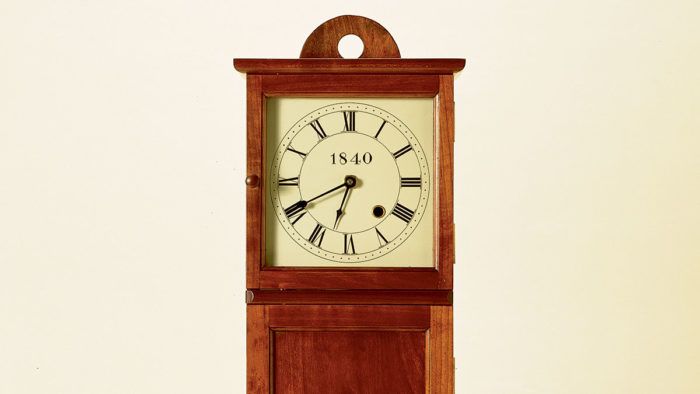Shaker-Style Clock
Modern works and classic design create convenient storage
Synopsis: This cherry and pine clock case accommodates a modern quartz movement. This Shaker clock Philip C. Lowe built is a little smaller than the original he based it on, so it fits well in modern interiors. He assembled the case with typical Shaker construction: Mortises and wedged through-tenons join the carcase, and blind mortise and tenon joints connect the door frames. He explains how he designed the clock and the hand-detailed stock preparation he undertook. Lowe talks about planning the mortises and tenons, completing the face, and making the grooves for double back panels. He used mitered molding on the frame-and-panel doors. A detailed project plan shows how he installed shelves in the pendulum area. Side information addresses reproducing an aged finish.
The simple beauty of Shaker styling teamed with modern clockworks offers an attractive and accurate timepiece as well as room for storage.
However, when I had a commission for such a Shaker clock, I found a lot of pictures of clocks, but no dimensioned drawings. So I scaled my design from a photo.
Because of my clients’ space limitations, my version is only about 80% as large as the original. The dimensions of this downsized version fit very well in modern interiors. I proportioned the sides to the front, being careful to accommodate a modern quartz movement. That also left room for shelves in the lower compartment, which usually houses the pendulum.
The cherry and pine case is held together with typical Shaker construction: Mortises and wedged through-tenons join the carcase, and blind mortise-and-tenon joints connect the door frames.
Clock design
A frequent admonition for any project is to buy your hardware before beginning to build. This is particularly true for a clock. You must accommodate hinges, latches and clockworks, and don’t forget to allow enough room between the clock’s face and the glass in the door for the hands.
Although original Shaker clocks had wooden works, I substituted a quartz movement from Klockit, Inc. Because the quartz movement I chose didn’t have a pendulum, I added some shelves to the bottom compartment to make a convenient storage place for small items.
Hand-detailed stock preparation
I use the normal array of woodshop machines, such as a jointer, planer, tablesaw and crosscut saw, to dress and dimension stock slightly oversized for my projects. But to add a true, handcrafted touch and to remove machinery millmarks, I make a couple of light passes on each face and edge of the stock with a handplane. To cut pieces to length, I scribe my cutting line with a knife, rough cut shy of the line on the tablesaw and then handplane to the scribed line. I mold the edges of the top, bottom and doors on a table-mounted router with the appropriate bit.
From Fine Woodworking #101
For the full article, download the PDF below:
Fine Woodworking Recommended Products

Stanley Powerlock 16-ft. tape measure

Estwing Dead-Blow Mallet

Blackwing Pencils























Comments
Great job, Phil, and it could have been improved with the addition of a pendulum, which you can get with a quartz movement so equipped.
Log in or create an account to post a comment.
Sign up Log in